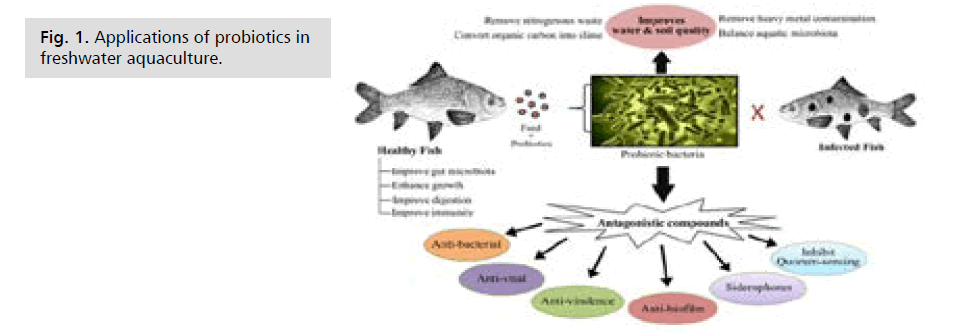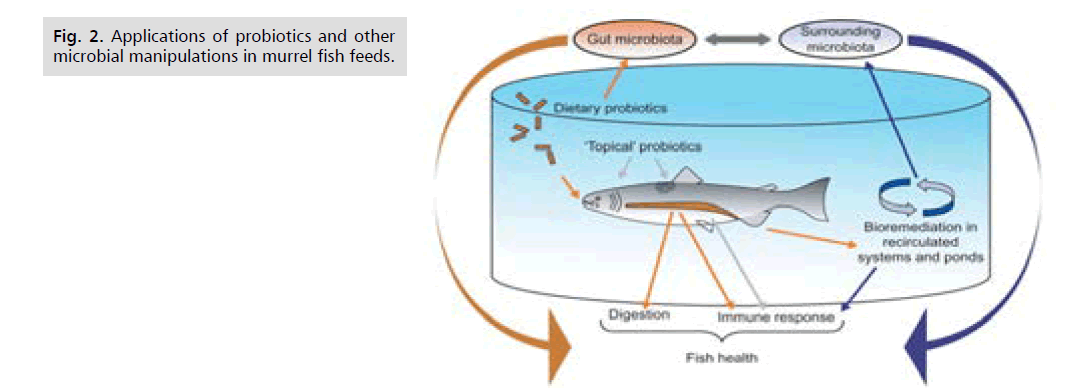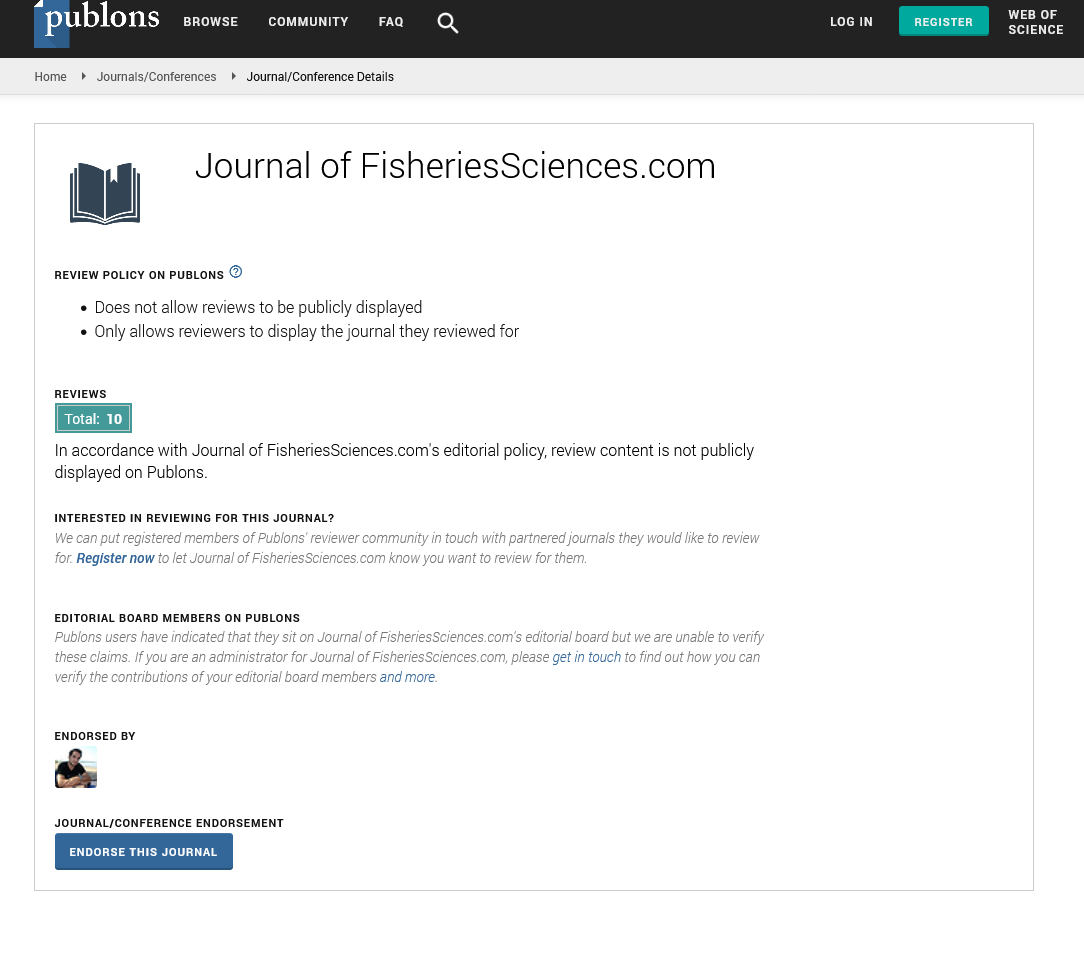Review Article - (2023) Volume 5, Issue 17
Applications of probiotics in freshwater murrel fishes
Podeti Koteshwar Rao* and
K. Ganesh
Department of Zoology, Kakatiya University, Telangana, India
*Correspondence:
Podeti Koteshwar Rao, Department of Zoology, Kakatiya University, Telangana,
India,
Email:
Received: 14-Jun-2023, Manuscript No. IPFS-23-14046;
Editor assigned: 17-Jun-2023, Pre QC No. P-14046 (PQ);
Reviewed: 02-Jul-2023, QC No. Q-14046;
Revised: 18-Aug-2023, Manuscript No. R-14046 (R);
Published:
15-Sep-2023
Abstract
Probiotic products were seen as an alternative to antibiotic use in freshwater
murrel fish farming. Probiotic microorganisms such as bacteria, yeast and fungi
provide several benefits to fish such as growth promotion, pathogen
suppression and improvement of food digestion, poor water quality and stress
tolerance agents, and reproduction enhancement. As a result, the purpose of
this review is to identify the major trends in probiotics in freshwater murrel
fishes. In probiotic research and commercial uses for freshwater murrel fishes,
strategies for including probiotic strains in fish feed or pellets to allow optimal
survival of the strains when they reach the fish Gastrointestinal Tract (GIT) are
critical.
Keywords
Probiotic; Yeast; GIT; Microorganisms
Introduction
The aquaculture business in many tropical and
subtropical nations is dominated by Channa species, which is
one of the most important protein sources from freshwater fish.
Antibiotics and chemicals have traditionally been used to treat
infectious illnesses in fish. Probiotics derived from the native
gastrointestinal microbiota of fishes have been more popular as
an alternative to antibiotics during the last two decades.
Probiotic species such as bacteria, yeast, and fungi are
frequently found in fish GIT and can be used singly or in mixes
or consortia [1,2].
More than 150 million tonnes of fish were produced worldwide
in 2017, with China producing the most, accounting for 4 million
tonnes of the total. By 2030, aquaculture is predicted to account for
nearly 62% of consumed fish, with wild-caught fish accounting for
38%. However, one of the major challenges in commercial aquatic
organism culture is the emergence of infectious illnesses that
threaten industrial sustainability. Disease is cited as the primary
cause of productivity and economic resource losses by a number of
academics and producers [3,4].
Aquaculture is the farming of aquatic creatures by intervention
in the raising process in order to increase production and private
ownership of the stock being grown. In comparison to this fishing
output. Aquaculture has grown in importance around the world
as a result of overfishing of wild species. Aquaculture has made a
significant contribution to global food production, raw materials
for industrial and pharmaceutical application and aquatic
organisms for stocking or ornamental commerce in recent decades
[5].
According to the World aquaculture 2012 report, worldwide
aquaculture production increased by more than 30% between
2006 and 2011, from 47.3 million tonnes to 63.6 million tonnes.
Furthermore, under these intense production settings, aquatic
species are subjected to high-stress conditions, increasing the
frequency of illnesses and decreasing productivity. Outbreaks of
viral, bacterial and fungal illnesses have resulted in massive
economic losses around the world; for example, China recorded
disease-related losses of $750 million in 1993, while India claimed
$210 million losses from 1995 to 1996. Furthermore,
considerable animal mortality has been recorded as a result of
inadequate farm environmental conditions, uneven feeding, toxin
production and genetic variables [6].
Literature Review
Proper probiotic strain selection is crucial because inappropriate strains can have negative effects on the host. The basic goals of
selecting probiotics are that they be safe and deliver desirable
results. They must also maintain their ability during manufacture,
manufacturing, distribution and storage before reaching the
customer. The good and successful probiotics should have a few
specific characteristics that are listed below [7].
The characteristics of good probiotics are:
• It should be a strain capable of exerting a beneficial effect
on the host animal, e.g. increased the growth or resistance
to disease.
• It should be a non-pathogenic and non-toxic.
• It should be present as viable cells and preferably in large
number.
• It should be capable of surviving and metabolizing in the
gut environment, e.g. resistance to low pH and organic
acids.
• It should be stable and capable of remaining viable for
longer periods under storage and field conditions.
Definition of probiotics
The name "probiotic" is derived from the Greek words pro
and bios, which signify "life" and has taken on several meanings
over time. Dr. Elie Metchnikoff was the first to describe the
beneficial role of some bacteria among farmers who consumed
pathogen-containing milk in 1905 and he stated that "reliance on
gut microbes for food makes it possible to take steps to change
the flora of our bodies and to replace harmful microbes by
beneficial microbes". However, Lilly and Stillwell did not coin
the name "probiotic" until 1965 as a derivative of the original
word "probiotika."
It was used to explain microorganism-produced
compounds that prolong the logarithmic growth phase in
other species. It was described as an agent that serves the
opposite purpose of antibiotics. Sperti later amended the term
"tissue extracts that stimulate microbial growth." Parker coined
the term to denote a microbial feed/food supplement in 1974. It
was defined by him as "organisms and substances that contribute
to intestinal microbial balance." Fuller broadened the definition
to "live microbial food supplement that benefits the host (human
or animal) by improving the microbial balance of the body" and
claimed that it would be successful under a variety of extreme
temperature and salinity fluctuations [8].
Probiotics were later defined as "monocultures or mixed cultures
of microorganisms applied to animals or humans that benefit
the host by improving the properties of indigenous microflora".
Guarner and Schaafsma postulated in 1998 that probiotics are
live bacteria that, when taken in sufficient quantities, offer health
advantages to the host.
Discussion
Applications of probiotics
The requirement for sustainable aquaculture has fueled
research into the use of probiotics on aquatic species. The early
focus was on their usage as growth promoters and to improve
animal health; however, other areas of interest have been
discovered, such as their effect on reproduction or stress
tolerance, albeit this requires more scientific study [9].
Growth promoter
Probiotics have been employed in aquaculture to boost
the growth of cultured species; however, it is unknown whether
these items increase hunger or improve digestibility by nature.
Some people believe that it could be a combination of both
aspects; additionally, it would be crucial to verify whether
probiotics genuinely taste good for aquaculture animals.
According to Balcazar, et al. probiotic microorganisms can
colonise the gastrointestinal tract when administered over time
because they have a higher multiplication rate than the rate of
expulsion, so as probiotics are constantly added to fish cultures,
they adhere to the intestinal mucosa, developing and exercising
their multiple benefits. H ydrobiont s pecies, b ody t emperature,
enzyme levels, genetic resistance and water quality all have a role
[10].
Probiotics have been tested on phytoplankton (microalgae),
which forms the foundation of aquatic food chains due to its
nutrient-producing photosynthetic machinery, which higher
organisms are unable to synthesise in most situations, such
as polyunsaturated fatty acids and vitamins. Central diatoms
such as Chaetoceros spp. have proven to be an excellent live food
within groups of microalgae utilised in aquaculture; nevertheless,
production is limited due to the intricacy of their nutritional
requirements. Figure 1 depicts the use of probiotics in
freshwater murrel fishes (Fig. 1.).

Figure 1: Applications of probiotics in
freshwater aquaculture.
The inhibition of pathogens antibiotics
They have long been used in aquaculture to avoid crop
diseases. However, this resulted in a number of concerns,
including the accumulation of antibiotic residues in animal
tissues, the development of bacterial resistance mechanisms, and
an imbalance in the gut microbiota of aquatic species, which
harmed their health. The European Union, in fact, has limited
the use of antibiotics in organisms intended for human
consumption. Consumers today want natural products that
are free of ingredients such as antibiotics; also, there is a trend
towards disease prevention rather than disease treatment. Thus,
the use of probiotics is a potential option for pathogen
suppression and disease control in aquaculture species [11].
Improvement in nutrient digestion
According to the study, probiotics benefit aquatic
animals' digestive processes since probiotic strains synthesise
extracellular enzymes such as proteases, amylases, and lipases as
well as supply growth factors such as vitamins, fatty acids, and
aminoacids. As a result, when probiotics are added to feed,
nutrients are absorbed more efficiently. In this regard, probiotics have been employed in edible species, such as European bass
larvae (Dicentrarchus labrax).
The probiotic yeast D ebaryomyces hansenii HF1 has been
shown to be capable of producing spermine and spermidine, two
polyamines important in the differentiation and maturation of the
gastrointestinal tract in mammals. Water quality was measured in
various studies after the inclusion of probiotic bacteria, particularly
those from the gram-positive genus Bacillus. Probably because
this bacterial type converts organic materials to CO2 more
efficiently than gram-negative bacteria. Maintaining high levels of
probiotics in production ponds may allow fish farmers to reduce
the accumulation of dissolved and particulate organic carbon
throughout the growing season [12].
Furthermore, this can balance phytoplankton production. This
theory, however, could not be substantiated in studies conducted
during prawn or channel catfish production employing one or
more species of Bacillus, Nitrobacter, Pseudomonas, Enterobacter,
Cellulomonas, and Rhodopseudomonas. Except for nitrification,
published evidence for enhancing water quality is so limited. Figure 2 depicts the microbial modifications of probiotics (Fig. 2.).

Figure 2: Applications of probiotics and other
microbial manipulations in murrel fish feeds.
Stress tolerance
Aquaculture practises necessitate intensive output in
shorter periods of time, putting crop species under stress.
Chronic stress, for example, has been shown in Channa
striatus and Channa punctatus fish to cause an overall
decrease in muscle protein synthesis. As a result, probiotics
were used to boost stress tolerance. In addition to assessing
growth improvement, the stress hormone cortisol was measured
in fish tissue as a stress marker because it is directly implicated in
the animal's response to stress.
Another method for measuring stress in fish is to subject
them to heat shock, as was done with Japanese flounder
(Paralichthys olivaceus) grown in a recirculating system.
Breeding aquaculture species have high nutritional
requirements, hence reproductive capacity is dependent on
adequate concentrations of lipids, proteins, fatty acids,
vitamins C and E and carotenoids, according to. Furthermore,
the interaction of these components effects reproduction in a
variety of processes like as fertility, fertilisation, birth and
larval development. At the moment, most cultured fish species
have commercially available "broodstock diets" that are simply
larger-sized diets.
Unprocessed fish products frequently may not supply
enough quantities of nutrients required by broodstock fishes,
increasing the risk of disease transfer to parents and offspring,
including parasites, bacteria, and viruses. As a result, probiotics
given to food or water were employed to prevent illnesses and
investigate their effect on reproduction. Conducted the first
study on the effect of probiotic supplementation on fish
reproductive performance, employing a strain of B. subtilis obtained from the intestines of Channa striatus and Chnna
punctatus. Furthermore, these researchers hypothesised that
complex B vitamins synthesised by the probiotic, particularly
thiamine (vitamin B1) and vitamin B12, help to lower the amount
of dead or deformed alevins [13].
Safety considerations of probiotics
Probiotics used in the food sector have traditionally been
believed harmless; in fact, no human dangers have been
identified, serving as the best indication of its safety. In theory,
probiotics could cause four types of negative effects in vulnerable people: Systemic infections, harmful metabolic activities,
excessive immunological stimulation and gene transfer. However,
no concrete proof has been discovered. There have been few
instances of bacteremia in people, when the isolation of probiotic
bacteria from illnesses appears to be the result of an opportunistic
infection caused by skin sores, cancer, chronic sickness or a druginduced
aberration. These circumstances cause a breakdown in
the intestinal barrier, allowing bacteria to penetrate through the
mucosal epithelium. Subsequently, these microorganisms are
transported to the mesenteric lymph nodes and other organs,
leading to bacteremia that may progress to septicemia.
Conclusion
The current global food crisis, as well as rising fish
production costs, have put pressure on governments and the
international community to secure a sustainable food supply
for a growing population. Thus, aquaculture is presented as a
way to meet the growing demand for fresh water food or
seafood, as well as to meet current challenges related to
ongoing globalisation of trade, intensification and
diversification of aquaculture, progress in technological
innovations for food production, changes in ecological systems and
human behaviour, including a greater awareness to protect
biodiversity, public health, and the environment. These issues will raise interest in improving aquaculture practises,
making it an important alternative to the overexploitation and
alteration of aquatic ecosystems caused by capture fisheries.
Using biochemical, morphological, and molecular approaches, a
variety of probiotic strains found in the GIT of aquatic animals
and nitrifying bacteria from biofilters have been identified and
characterised. The evolution of molecular tools such as PCR, FISH
(Fluorescent In situ Hybridization), DGGE (Denaturing Gradient
Gel Electrophoresis), and genomic library production has begun to
reveal the diversity present in aquaculture systems. At the moment,
next-generation sequencing technologies hold significant promise
for phylogenetic identification of probiotic microbes without the
need of traditional cultivation procedures.
Acknowledgement
Authors with to thanks Dr. P. Srinivas plant pathology
and microbiology laboratory, department of biotehnology,
Kakatiya university, Warangal for his continuous support and
inspiration and providing necessary facilities for the work.
Conflict of Interest
All authors declare no conflict of interest.
Authors’ Contributions
(A) Study Design · (B) Data Collection . (C) Statistical
Analysis · (D) Data Interpretation · (E) Manuscript Preparation · (F) Literature
Search · (G) No Fund Collection.
References
- Pandiyan P, Balaraman D, Thirunavukkarasu R, et al. Probiotics in aquaculture. Drug Invention Today. 2013; 5(1): 55-59.
[Crossref] [Google Scholar]
- Lafferty KD, Harvell CD, Conrad JM, et al. Infectious diseases affect marine fisheries and aquaculture economics. Annu Rev Mar Sci. 2015; 7: 471-496.
[Google Scholar]
- Ebeling JM, Timmons MB. Recirculating aquaculture systems. Aquaculture. 2012; 11: 245-277.
[Crossref] [Google Scholar]
- Nachimuthu R, Royam MM, Manohar P, et al. Application of bacteriophages and endolysins in aquaculture as a biocontrol measure. Biol Control. 2021; 160: 104678.
[Crossref] [Google Scholar]
- Bondad-Reantaso MG, Subasinghe RP, Arthur JR, et al. Disease and health management in Asian aquaculture. Vet Parasitol. 2005; 132: 249-272.
[Crossref] [Google Scholar]
- Kautsky N, Ronnback P, Tedengren M, et al. Ecosystem perspectives on management of disease in shrimp pond farming. Aquaculture. 2000; 191: 145-161.
[Crossref] [Google Scholar]
- Ige BA. Probiotics use in intensive fish farming. Afr J Microbiol Res. 2013; 7: 2701-2711.
[Google Scholar]
- Fuller R. Probiotics in man and animals. J Appl Bacteriol. 1989; 66: 365-378.
[Google Scholar] [PubMed]
- Michael ET, Amos SO, Hussaini LT. A review on probiotics application in aquaculture. Aqua Fish. 2014; 5: 1-2.
[Crossref] [Google Scholar]
- Shewale RN, Sawale PD, Khedkar CD, et al. Selection criteria for probiotics: A review. Int J Probiotics Prebiotics. 2014; 9: 16-17.
[Google Scholar]
- Balcazar JL, de Blas I, Ruiz-Zarzuela I, et al. The role of probiotics in aquaculture. Vet Microbiol. 2006; 114: 173-186.
[Crossref] [Google Scholar] [PubMed]
- Gatesoupe FJ. The use of probiotics in aquaculture. Aquaculture. 1999; 180: 147-165.
[Google Scholar]
- Gram L, Melchiorsen J, Spanggaard B, et al. Inhibition of Vibrio anguillarum by Pseudomonas fluorescens AH2, a possible probiotic treatment of fish. Appl Environ Microbiol. 1999; 65: 969-973.
[Crossref] [Google Scholar] [PubMed]








